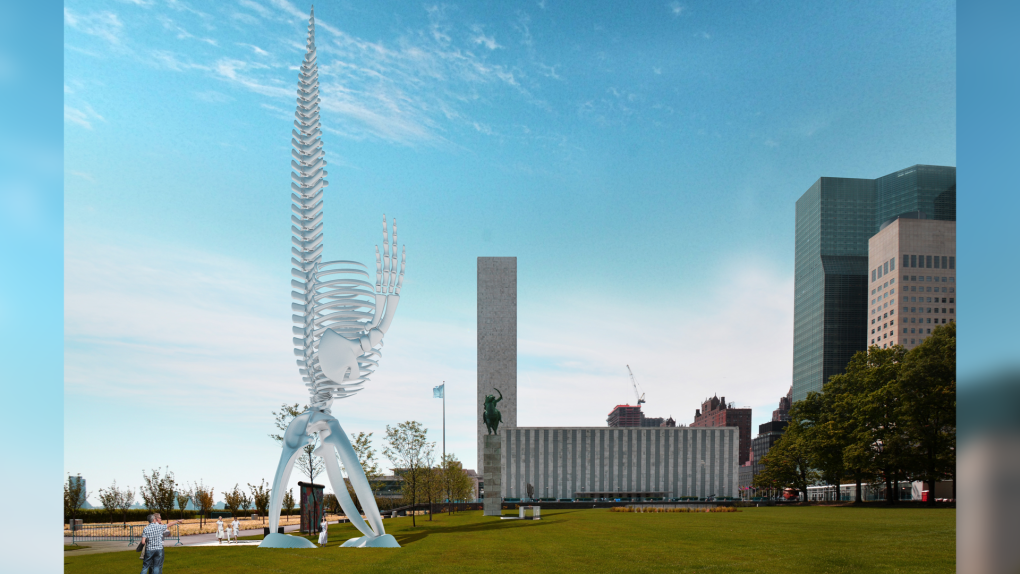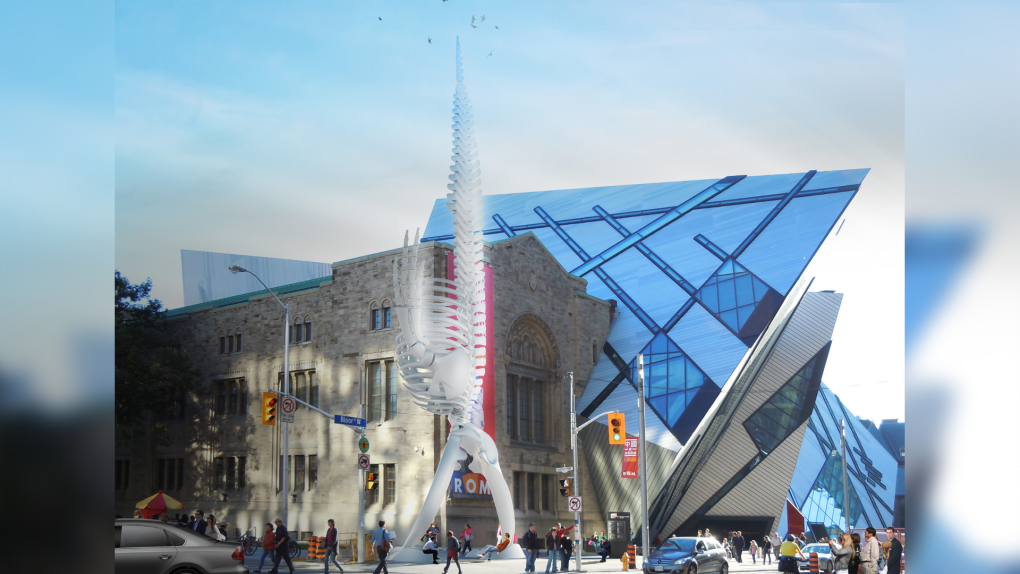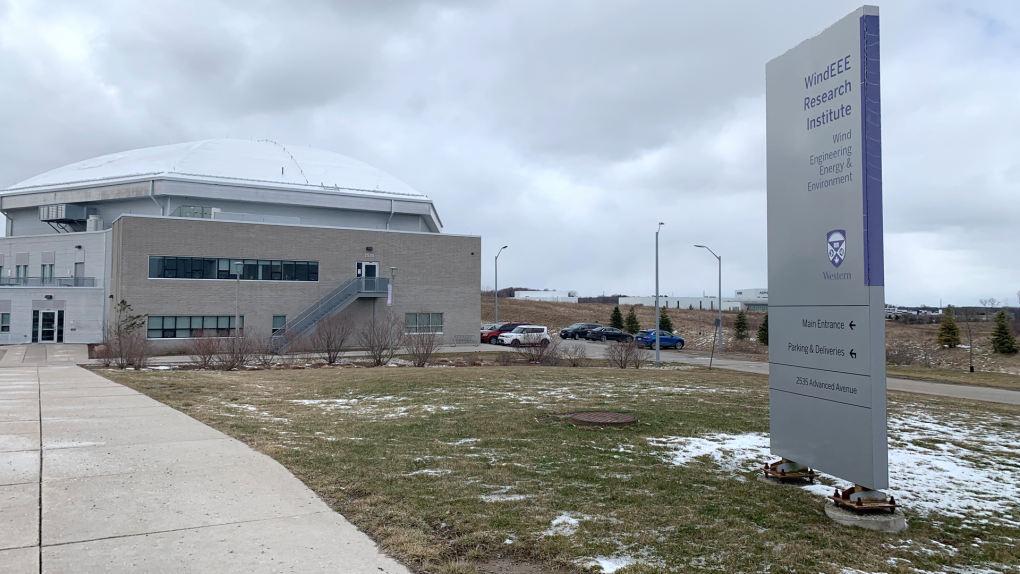Will the Standing Whale withstand the wind? Western University model testing a unique art piece inside WindEEE
A collaboration between world-renowned Canadian photographer Edward Burtynsky, Queens University, and Western University, is working to realize a new art piece titled ‘Standing Whale.’
A 3D printed stainless steel scale model is being put to the test inside the Wind Engineering, Energy, and Environment Research Institute (WindEEE RI) in London, Ont.
"One of a kind facility, not only in Canada, in a humble Canadian way, even in the world. It's very unique,” said Girma Bitsuamlak, director of WindEEE RI.
Inside WindEEE RI, engineers can simulate the impact of different types of high-force winds, including tornadoes, thunderstorm microbursts, and downbursts.
Engineers are working on testing the strength of a unique structure that is the work of Burtynsky, who hopes his public sculpture, a true-to-size re-imaging of a whale skeleton, will convey the importance of climate change, environmental stewardship, and biodiversity loss.
 Conceptual sketches of the ‘Standing Whale’ in front of the UN building. (Source: Edward Burtynsky photography)
Conceptual sketches of the ‘Standing Whale’ in front of the UN building. (Source: Edward Burtynsky photography)
But in order to make that happen, critical testing to determine the behaviour of the structure in the wind must be completed. The team has come to Western University, a leader in the world when it comes to wind engineering.
“We have 106 fans on the wall and the ceiling of the system. We control each fan individually. When you have this kind of flexibility and control, you can generate different kinds of wind systems. It's very unique in that sense," explained Bitsuamlak.
Burtynsky has been working with Think2Thing Design Director David Didur for nearly eight years to help conceptualize the Standing Whale.
“It’s through this collaboration we’re hoping to find a solution to have an aesthetically pleasing piece with no compromises, yet with sound engineering,” said Didur.
 Conceptual sketches of the ‘Standing Whale’ in front of the ROM in Toronto. (Source: Edward Burtynsky photography)
Conceptual sketches of the ‘Standing Whale’ in front of the ROM in Toronto. (Source: Edward Burtynsky photography)
Burtynsky is also working closely with Queens University, engaging with faculty and students in multiple programs, tackling the piece's structural and conceptual challenges with the aim of bringing this artwork to life in a public setting.
“We don’t have a facility were we can test the full scale sculpture, so what we have here is we have a 1 to 25 scale model. So the actual sculpture is 25 times bigger than the one you see here, and we scale the wind and all of the properties of the model so that we essentially get a realistic representation of what its behaviours will be here when we are done,” explained Josh Woods, civil engineering assistant professor at Queens University.
The data from the testing will allow the team to fabricate the 74-foot sculpture, a process that will take approximately two years.
A location for the unique art piece is yet to be determined.
 Exterior of the WindEEE facility in London, Ont. on March 20, 2024. (Reta Ismail/CTV News London)
Exterior of the WindEEE facility in London, Ont. on March 20, 2024. (Reta Ismail/CTV News London)
CTVNews.ca Top Stories

More than 115 cases of eye damage reported in Ontario after solar eclipse
More than 115 people who viewed the solar eclipse in Ontario earlier this month experienced eye damage after the event, according to eye doctors in the province.
Toxic testing standoff: Family leaves house over air quality
A Sherwood Park family says their new house is uninhabitable. The McNaughton's say they were forced to leave the house after living there for only a week because contaminants inside made it difficult to breathe.
Decoy bear used to catch man who illegally killed a grizzly, B.C. conservation officers say
A man has been handed a lengthy hunting ban and fined thousands of dollars for illegally killing a grizzly bear, B.C. conservation officers say.
B.C. seeks ban on public drug use, dialing back decriminalization
The B.C. NDP has asked the federal government to recriminalize public drug use, marking a major shift in the province's approach to addressing the deadly overdose crisis.
OPP responds to apparent video of officer supporting anti-Trudeau government protestors
The Ontario Provincial Police (OPP) says it's investigating an interaction between a uniformed officer and anti-Trudeau government protestors after a video circulated on social media.
An emergency slide falls off a Delta Air Lines plane, forcing pilots to return to JFK in New York
An emergency slide fell off a Delta Air Lines jetliner shortly after takeoff Friday from New York, and pilots who felt a vibration in the plane circled back to land safely at JFK Airport.
Sophie Gregoire Trudeau on navigating post-political life, co-parenting and freedom
Sophie Gregoire Trudeau says there is 'still so much love' between her and Prime Minister Justin Trudeau, as they navigate their post-separation relationship co-parenting their three children.
Last letters of pioneering climber who died on Everest reveal dark side of mountaineering
George Mallory is renowned for being one of the first British mountaineers to attempt to scale the dizzying heights of Mount Everest during the 1920s. Nearly a century later, newly digitized letters shed light on Mallory’s hopes and fears about ascending Everest.
Loud boom in Hamilton caused by propane tank, police say
A loud explosion was heard across Hamilton on Friday after a propane tank was accidentally destroyed and detonated at a local scrap metal yard, police say.



























